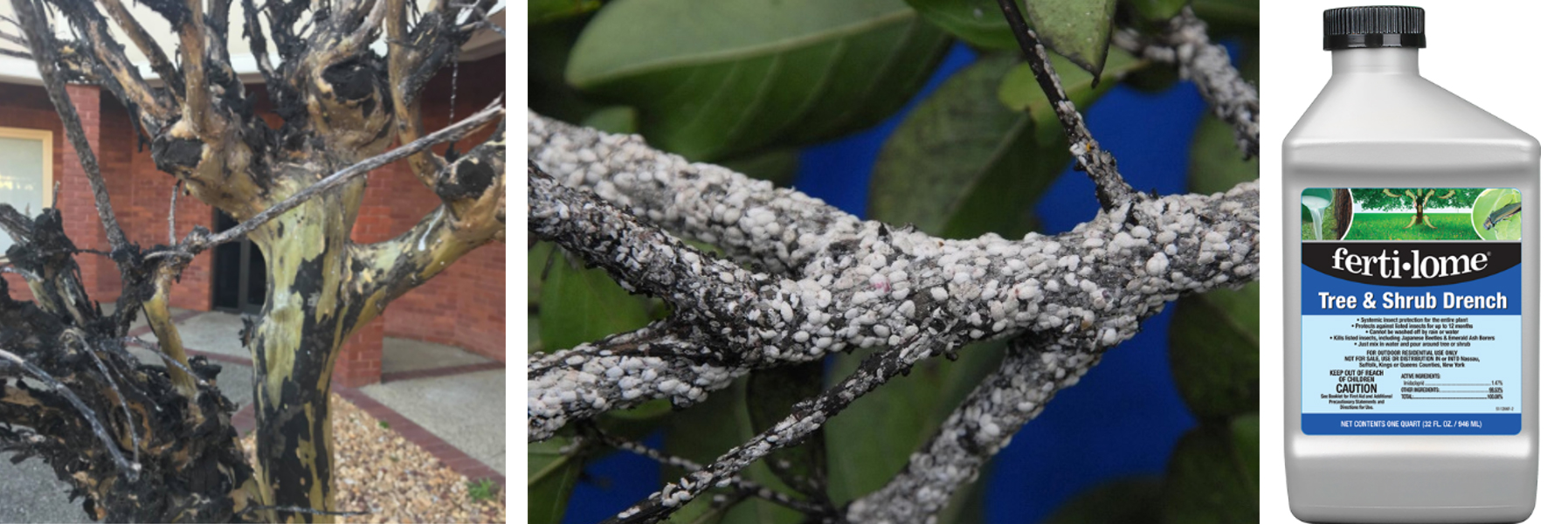 By Kathy Torres
By Kathy Torres
A problem that is becoming more prevalent in South Carolina, affecting one of the most popular ornamental trees grown in our region, is Crape Myrtle Bark Scale (Acanthococcus lagerstroemiae). Scale is an insect, however the infestation results in sooty mold, which is a disease. This combination can drastically affect the appearance and health of the tree. CMBS was initially sighted in 2004 in McKinney, Texas (known for an abundance of Crape Myrtles), making its way across Texas and Louisiana by 2013, and eventually throughout the Southeast, the first case arriving in South Carolina in 2019. It is treatable and typically won’t kill the tree but can affect blooming and the appearance of the trunks and branches of this beautiful species.
A little science on how it all starts (from Clemson’s Home and Garden Fact Sheet)… “The small CMBS males are winged and will fly to find females and to mate. Once the mated females produce their ovisacs (egg-containing capsules) and lay eggs, they die. The eggs remain protected within the white colored ovisacs until the crawlers (immatures) hatch and disperse onto the branches. Each female lays about 60 to 250 eggs, which may over-winter within their ovisacs, and then hatch during mid- to late April to May. The crawlers are pink, very small, and may not be noticed without a hand lens. A second peak in crawler activity occurs in late summer. These mobile crawlers move out to new twigs and branches to settle down and begin feeding on the sugary phloem layer beneath the bark.” As the insects feed, they excrete a sweet, sticky substance known as honeydew. A black, sooty mold forms over the honeydew on stems, and trunks, (rarely on leaves), followed by white or gray specks. Aphids and Mealy Bugs can also create similar white specks, so it’s a good idea to take a picture and seek assistance to correctly identify the problem.
If this scale is identified, it is important to treat as soon as possible. The sooty mold can be washed off by using warm soapy water in a sprayer. In winter when temperatures remain cool, apply an oil-based insecticide, such as Neem Oil or Horticulture Oil, if you find evidence of CMBS. This will smother many of the crawlers and adults. Unfortunately, it is unlikely that the oil will kill them all, so be prepared in late March or early May, to treat with a systemic insecticide (treats the plant through the root system). Wingard’s recommends Fertilome Tree & Shrub Drench, which offers 12-month control. Preventive treatment is typically not necessary after application of the systemic insecticide, however the dead insects may remain on the tree. Be sure to monitor other Crape Myrtle trees in the landscape, due to the invasive nature of CMBS.
To improve the appearance of the infested tree and to minimize the treatment area, you may want to remove some affected limbs. To avoid the spread of CMBS, do not put limbs in a compost pile or out on the curb for pick up, or even in an open truck. Best practice is to double-bag and dispose of them along with your regular trash.
For help identifying CMBS, contact Wingard’s or the Clemson Extension Service, 605 W. Main Street, Suite 109, Lexington, (803) 359-8515. Rather than bringing a cutting into the garden center, please bring us a picture (close-up view) and we will be glad to provide assistance.
Don’t let the fear of CMBS deter you from planting one or more of the many beautiful varieties of Crape Myrtle. Making a perfect anchor plant for the home or a focal point in a flower bed, this addition to the landscape will provide beautiful color in the summer and many varieties have great fall foliage color. Just keep an eye on them and nip CMBS in the bud before it becomes a problem.

